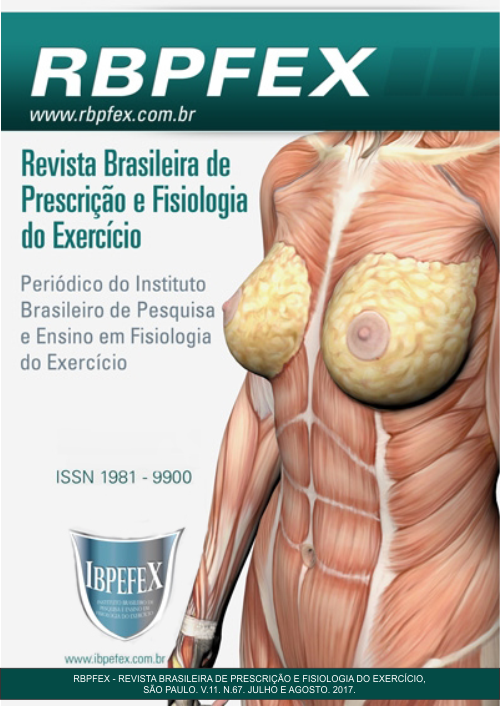Acute effects of different warm-ups strategies on the performance of maximum repetitions in bench press in young adult men
Abstract
To evaluate the acute effects of different warm-ups strategies on the performance of maximum repetitions in bench press in young adult men, 15 men (26 ± 5 years old; body mass: 78 ± 6 kg; height: 172 ± 7 cm) were underwent to the maximum strength test (1RM) in bench press exercise and after 20 minutes a new test performed external overload control 70%1RM (CON) concentric to mechanical failure. The other sessions consisted of five separate warm-ups models, randomized, being: 1) strength resistance (RF): 15 reps at 40% 1RM; 2) static stretching (AE): used the static method with two 20-second series for each position, which were applied in the pectorals, deltoids and triceps; 3) aerobic exercise (AE): 5 min at 50%VO2max on a treadmill and 4) (EA+AE); for the group the same exercises of EA and EA groups were conducted. After the specific warm-up was given 1 min recovery interval and it was made the maximum repetitions test with 70% 1RM. The results of this study demonstrate that the yield in the implementation of the bench press exercise showed significant differences between the following warm-ups strategies: CON x AE (p=0.0247), CON X EA (p=0.0003) and COM X EA + AE (p=0.0166), only warm-up using 40% 1RM (RF), did not show significant differences when compared to the control group (p = 0.3639). In conclusion, our data demonstrate that different warm-ups models impacted positively muscle performance in young-adult men, increasing the performance of the maximum repetitions test in the bench press, without, however, to differentiate each other.
References
-Ament, W.; Verkerke, G.J. Exercise and fatigue. Sports Med. Vol. 39. Núm. 5. p. 389-422. 2009.
-Baechle, T.R.; Earl, R.W. Fundamentos do Treinamento de Força e do Condicionamento Físico. São Paulo: Manole. 2010.
-Behm, D.G.; Button, D.C.; Butt, J.C. Factors affecting force loss with prolonged stretching. Can J Appl Physiol. Vol. 26. p. 261-272. 2001.
-Bishop,D. Warm up I: potential mechanisms and the effects of passive warm up on exercise performance. Sports Med. Vol. 33. Núm. 6. p. 439-454. 2003.
-Bishop, D. Warm up II. Performance changes following active warm-up and how to structure the warm-up. Sports Medicine. Vol. 33. Núm. 7. p. 483-498. 2003.
-Di Alencar, T. A. M.; Matias, K. F. S. Princípios fisiológicos do aquecimento e alongamento muscular na atividade esportiva. Revista Brasileira de Medicina do Esporte. Vol. 16. Núm. 3. p. 23-234. 2010.
-Endlich, P.W.; Farina, G.R.; Dambroz, C.; Gonçalves, W.L.S.; Moysés, M.R.; Mill, J.G. Efeitos agudos do alongamento estático no desempenho da forca dinâmica em homens jovens. Rev Bras Med Esporte. Vol. 15. Núm. 3. p. 200-203. 2009.
-Fermino, R. C.; Winiarski, Z. H.; Rosa, R. J.; Lorenci, L. G.; Buso, S.; Simão, R. Influência do aquecimento específico e de alongamento no desempenho da força muscular em 10 repetições máximas. Revista Brasileira de Ciência e Movimento. Vol. 13. Núm. 4. p. 25-32. 2005.
-Luz Junior, D. A.; e colaboradores. Diferentes aquecimentos no desempenho de repetições máximas na musculação. Rev Bras Med Esporte. Vol. 20. Núm. 6. 2014.
-Marchetti, P.H.; Arruda, C.C.; Segamarchi, L.F.; Soares, E.G.; Ito, D.T.; Luz Junior, D.A. Exercício supino: uma breve revisão sobre os aspectos biomecânicos. Braz. J. Sports and Exerc. Res. Vol. 1. Núm. 2. p. 135-142. 2010.
-Nader, A.N.; Silva, A.M.G.; Rocha, H.N.B.; Chaves, C.P.G.; Miranda, H.; Simão, R. Influência dos aquecimentos geral e específico na força de membros superiores. Revista Brasileira de Prescrição e Fisiologia do Exercício. Vol. 3. Núm. 18. p. 517-521. 2009. Disponível em: <http://www.rbpfex.com.br/index.php/rbpfex/article/view/203/206>
-Nicoli, A.I.V.; Cordova, K.O.; Barreto, A.C.L.Y.G.; Novaes, J.S. Influência dos diferentes tipos de aquecimento no número de repetições nos exercícios resistidos. Arq Mov. Vol. 3. Núm. 2. p. 42-55. 2007.
-Power, K.; Behem, D.; Cahill, F.; Carroll, M.; Young, W. An acute bout of static stretching: effects on force and jumping performance. Med Sci Sports Exerc. Vol. 36. Núm. 8. p. 1389-1396. 2004.
-Raddi, L.L.O.; Gomes, R.V.; Charro, M.A.; Bacurau, R.F.P.; Aoki, M.S. Treino de corrida não interfere no desempenho de força de membros superiores. Rev Bras Med Esporte. Vol. 14. Núm. 6. p. 544-547. 2008.
-Robergs, A.; Roberts, S. O. Princípios Fundamentais de Fisiologia do Exercício: para Aptidão, Desempenho e Saúde. São Paulo. Phorte. 2002.
-Shrier, I. Does stretching improve performance? A systematic and critical review of the literature. Clin J Sport Med. Vol. 14. Núm. 5. p. 267-273. 2004.
-Simão, R.; Senna, G.; Leitão, N.; Arruda, R.; Priore, M.; Maior, A.M. Influência dos diferentes protocolos de aquecimento na capacidade de desenvolver carga máxima no teste de 1RM. Fit Perf J. Vol. 3. Núm. 5. p. 261-5. 2004.
-Tricoli, V.; Paulo, A.C. Efeito agudo dos exercícios de alongamento sobre o desempenho de força máxima. Rev Atividade Física Saúde. Vol. 7. p. 6-13. 2002.
-Young, W.B.; Behm, D.G. Should static stretching be used during a warm-up for strength andactivities? Stren Cond J. Vol. 24. 6. p. 33-37. 2002.
Authors who publish in this journal agree to the following terms:
- Authors retain the copyright and grant the journal the right of first publication, with work simultaneously licensed under the Creative Commons Attribution License BY-NC which allows the sharing of the work with acknowledgment of the authorship of the work and initial publication in this journal.
- Authors are authorized to enter into additional contracts separately for non-exclusive distribution of the version of the work published in this journal (eg, publishing in institutional repository or book chapter), with acknowledgment of authorship and initial publication in this journal.
- Authors are allowed and encouraged to post and distribute their work online (eg, in institutional repositories or on their personal page) at any point before or during the editorial process, as this can bring about productive change as well as increase impact and impact. citation of published work (See The Effect of Free Access).






